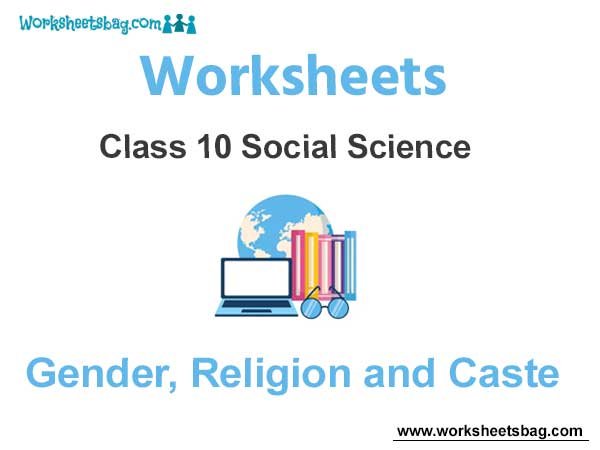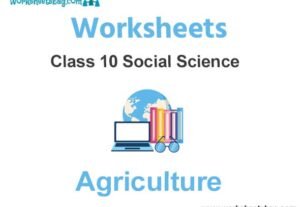Students should refer to Worksheets Class 10 Social Science Gender Religion and Caste Chapter 4 provided below with important questions and answers. These important questions with solutions for Chapter 4 Gender Religion and Caste have been prepared by expert teachers for Class 10 Social Science based on the expected pattern of questions in the class 10 exams. We have provided Worksheets for Class 10 Social Science for all chapters on our website. You should carefully learn all the important examinations questions provided below as they will help you to get better marks in your class tests and exams.
Gender Religion and Caste Worksheets Class 10 Social Science
Choose the Appropriate :
Question. Social divisons based on ___ are peculiar in India.
(a) disconfort
(b) Religon
(c) Caste
(d) Gender
Ans. (c) Caste
Question. When we speak fo gender divison, we usually refer to :
(a) Biological difference between the men and women.
(b) Unequal role assigned by society men and women.
(c) Unequal child sex ratio.
(d) Absence of voting rights for woman in democracy.
Ans. (b) Unequal role assigned by society men and women.
Question. Which among the following statements about Indian constitution in wrong ? It ……
(a) Prohibits discrimination on ground of religions
(b) Given official status to one religion.
(c) provides to all individuals freedom to profess any religons
(d) ensures equality of citizens within religious communities.
Ans. (b) Given official status to one religion.
Question. In India seats are reserved for women in
(a) Lok Sabha
(b) State Legislative assemblies
(c) Cabinets
(d) Panchayati Raj bodies
Ans. (d) Panchayati Raj bodies
Question. Match List I with List Ii and select the correct answer the cues given below the list
| List I | List II |
| 1. A person who believes in equal rights and opportunities for women and men | A. Communal |
| 2. A person who says that religion is the principal basis of community | B. Feminist |
| 3. A person who thinks that caste is the principle basis of community | C. Secular |
| 4. A person who does not discriminate others on the basis of religious believes | D. Castiest |

Ans. (b) B, A, D, C is correct.
Short Answer Questions
Question. What is Gender division ?
Ans. Gender divison : It is a form of hierarchial social division of labour.
Question. What was the basis of caste system in India ?
Ans. It implies the shifting of population from rural areas to urban areas in search of jobs and better standard of life in urban areas.
Question. State the main provision of the ”Equal Weges Act”.
Ans. Equal wages should be paid to equal work to both men and women.
Question. How the caste of a person determined in India ?
Ans. By the caste of the family in which he is born.
Question. What is Patriarchy ?
Ans. Literally, rule by father or a system that values men more and given them power over women as in Indian society which is still a male dominated, patriarchal society.
Question. What is occupational mobility?
Ans. It relates to shift from one occupation to another, usually when a new generation takes up occupations other than those practised by ancestors.
Question. What is a Feminist movement ?
Ans. The radical movements demanding equality in political life, educational and other oppotunities for women are called feminist movements.
Question. Why are ”Scheduled Castes’ and ‘Scheduled Tribes’ called scheduled or prefix schedule ?
Ans. It is because their castes and tribes have been listed in a official schedule.
Question. What is Urbanisation ?
Ans. In India, hereditary occupetional divison was sanctioned by rituals and, therefore, caste system was based on exclusion of and discrimination against the ”outcaste” groups.
Question. How did Gandhi Ji defined religion ?
Ans. For Gandhi Ji, religion was not any particular religion like Hinduism or Islam but moral values that inform all religions.
Question. Name the two well known social reformers, who worked for the casteless society in India.
Ans. Gandhi Ji, Jyotiba Phule Ji, B. R. Ambedkar Ji.
Long Answer Questions
Question. Describe the role of caste politics in India.
Ans. The caste politics in India has helped SKs, STs and OBC’s to gain better access to decision making.
Question. What is the proportion of women in Indian legislative ? What can be done to improve the representation of women in legislative ?
Ans. (a) In Lok Sabha women are approx 11.23%
(b) In state assemblies women are approx. 5%
(c) In panchayat 1/3 seats are reservered for women.
Question. Give the reason which have contributed to changes in caste and caste system in India.
Ans. Reasons :
(a) Efforts of political leaders and social reformers like Gandhi ji and Ambedker Ji who advocated and worked to establish a society in which caste inequalties are absent.
(b) Socio economic reasons like urbanisation, growth of literaxy and education, Occupational mobility, weakening of land lord’s position in the village have led to the breaking down of caste hierarchy.
(c) The constitution of India prohibits any caste based discrimination that lays down the foundation of politics to end the injustices of the caste system.
Question. Describe main features of secular state in India.
Ans. (a) No official religons in India.
(b) Freedom of religion in India means the freedom of religion to both individuals and coomunities.
(c) The constitution prohibits discrimination on the grounds of religions.
Question. What steps have been taken by the government of India to improve the conditions of women in society ?
Ans. Following schemes and steps have been taken up by the govt. of India for women empowerment.
(a) Act prohibiting the practice of sati.
(b) The hindu widow remarriage Act
(c) The married women’s property Act
(d) Indira Gandhi Matritva Sahyog Yojna.
(e) Kishori Shakti Yojna
(f) The Dowry Prohibition Act.
(g) The Protection of woman from Domestic Violence Act 2005
(h) The Pre-Natal Diognostic Techniques Act.
(i) The equal Remuneretion Act.
Question. Explain the reasons behind change in caste and caste system in modern India.
Ans. Caste and caste system in modern India have undergone great changes became of …..
— Economic development
— Large scale urbanisation
— Growth of Literacy and education
— Occupational Mobility.
— Weakning of the position of landlords in the village.
Question. Caste can take various form in politics. Describe any five forms.
Ans. The caste can take following forms in politics :
(a) Sometimes candidates are chosen on the basis of their caste
(b) In many places, voters on the basis of caste and fail to choose suitable condidates.
(c) Political parties appeal to caste sentiments during election.
(d) To gain support poltical parties, raise caste based issues during elections.
(e) The castes considered inferior or low until now have been made conscious of their rights by the political parties.
Source Based Questions
Source-I
Boys and girls are brought up to believe that the main responsibility of women is housework and bringing up children. This is reflected in a SEXUAL DIVISION OF LABOUR in most families : women do all work inside the home such as cooking, cleaning, washing clothes, tailoring, looknig after children, etc., and men do all the work outside the home. It is not that men cannot do housework; they simply think that it is for women to attend to these things. When these jobs are paid for, men are ready to take up these works. Most tailors or cooks in hotels are men. Similarly, it is not that women do not work outside their home. In villages, women fetch water, collect fuel and work in the fields. In urban areas, poor women work as domestic helper in middle class homes, while middle class women work in offices. In fact the majority of women do some sort of paid work in addition to domestic labour. But their work is not valued and does not get recognition.
1. Define Sexual Division of Labour.
Ans. Sexual divison of labour is a system in which all work inside the home is eitehr done by the women of the family, or organised by them through domestic helpers.
2. Name the work, which men wishfully do when they are paid for it.
Ans. Job of Tailor, Cooks in hotel etc.
Source-II
Communal politics is based on the idea the religion is the principal basis of social community. Communalism involves thinking along the following lines. The followers of a particular religion must belong to one community. Their fundamental interests are the same. Any difference that they may have is irrelevant or trivial for community life. It also follows that people who follow different religions cannot belong to the same social community. If the followers of different religions have some commonalities these are superficial and immaterial. Their intrests are bound to be different and involve a conflict. In its extreme form communalism leads to the belief that people belonging to different religions cannot live as equal citizens within one nation. Either, one of them has to dominate the rest or they have to form different nations.
1. Define Communal politics.
Ans. Communal Polities : The use of religon in politics where one religion
in shown as superior to other religions in called communal politics.

